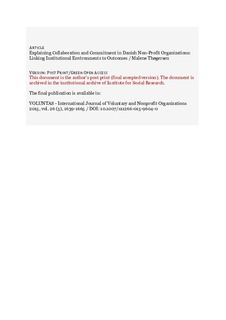Explaining Collaboration and Commitment in Danish Non-Profit Organizations: Linking Institutional Environments to Outcomes
Peer reviewed, Journal article
Accepted version
Date
2015Metadata
Show full item recordCollections
- Publikasjoner fra CRIStin [715]
- Tidsskriftpublikasjon [388]
Original version
VOLUNTAS - International Journal of Voluntary and Nonprofit Organizations. 2015, 26 (5), 1639-1665. 10.1007/s11266-015-9604-0Abstract
The aim of this paper is to shed light on the characteristics and impact of different institutional environments in non-profit welfare provision in Denmark. Based on an analytical framework inspired by the policy fields approach (Stone and Sandfort 2009), the paper argues that to understand the non-profit sector, it is necessary to take a closer look at the differences and similarities not only across welfare fields, but also across non-profit providers and their public counterparts within the same field. Based on data from case studies on primary schools and nursing homes in two Danish municipalities, a number of explanatory factors are identified and analyzed: Regulative rules, funding issues, norms and expectations, and the degree of competition. Results show important differences in the institutional environment of the two welfare fields, and that these differences have an actual impact on outcomes: Both collaborative activities of welfare providers and organizational commitment among leaders, employees, and users are highly influenced by characteristics of the institutional environment. It is argued that the applied analytical framework can help understand and explain the large variations in non-profit welfare provision across fields, within countries.
